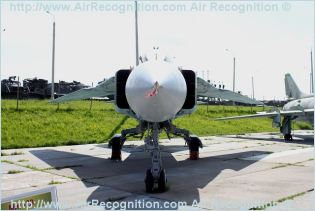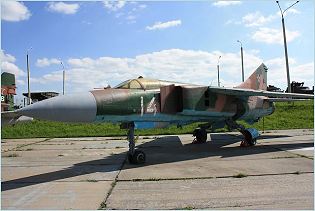MiG-23 Flogger Mikoyan
| a | ||||||||||||||||||||||
|
MiG-23 Flogger fighter aircraft
|
||||||||||||||||||||||
 |
||||||||||||||||||||||
|
The Mikoyan-Gurevich MiG-23 (NATO code reporting name: Flogger) is a variable-geometry fighter aircraft, designed by the Mikoyan-Gurevich design bureau in the Soviet Union. Work on the Mikoyan-Gurevich 'Flogger' started in the early 1960s, when Frontal Aviation (FA), the Soviet tactical air defense/ strike force, had taken delivery of numerous MiG-21s and Sukhoi Su-7s. The MiG bureau produced two prototype aircraft to the FA's specification, apparently sharing some common design features. One of these resembled an enlarged MiG-21, with the same mid-set delta wing and conventional tail, but to reduce the field length with-in reasonable bounds it was fitted with two lift-jet engines in the center-section. The other, designated Ye-231, was a straightforward application of the then-fashionable variable-sweep, or variable- geometry (VG) formula. It is probable that both of them made their first flights in late 1966 or early 1967; by the time they appeared at the air show held at Domodedovo, near Moscow, in June 1967, the weight penalties and control complications inherent in the lift-jet design had led to its abandonment in favor of the swing-wing Ye-231. Following the show, the delta received the NATO code-name 'Faithless' and the Ye-231 was named 'Flogger'. |
||||||||||||||||||||||
| Main Variants | ||||||||||||||||||||||
|
-Ye-231 'Flogger-A': bureau designation for prototype aircraft, flown in 1966-7
- MiG-23 'Flogger-A': small batch of service-test aircraft, similar to the prototype, produced in 1969-70 - MiG-23MF 'Flogger-B': much modified standard fighter variant, in service since 1973: steadily improved with R-29B engine, provision for external fuel and other modifications - MiG-23U 'Flogger-C': two-seat conversion/ proficiency trainer based on MiG-23MF - MiG-27 'Flogger-D': dedicated ground-attack aircraft based on MiG-23MF airframe with new forward fuselage, relocated pylons, six-barrel cannon and other changes - MiG-23 'Flogger-E': export fighter development of M»G-23MF with R-27 engtine,Jay Bird' radar and AA-2 'Atoll' missiles - MiG-23BN 'Flogger-F': export ground-attack type with MiG-27forward fuselage and MiG-23 type inlets and nozzle - MIG-23MF 'Flogger-G': further improved fighter with shorter dorsal fin extension and new nose landing gear; recent versions have six missile armament - MiG-23BN 'Flogger-H': similar to "Flogger-F" but with additional antenna - MiG-27 'Flogger-J': recent MiG-27 variant with modified nose and wing leading-edge root extensions; has been seen with underwing gun pods as primary armament |
||||||||||||||||||||||
| Technical Data | ||||||||||||||||||||||
| Design | ||||||||||||||||||||||
|
The MiG-23 falls squarely into the group of variable geometry (VG) aircraft conceived in the 1960s. VG made a particularly good match for the newly developed augmented turbofan engine. The turbofan's excellent thrust/weight ratio in reheat could drive a VG aircraft well above Mach 2. Without reheat, its miserly fuel consumption put previously unattainable range performance within reach of the fighter aircraft.
All the VG aircraft designed in the early 1960s had augmented turbofan powerplants, including the MiG-23; designated R-27, its engine was designed by the Tumansky bureau, which had powered the MiG-19, the MiG-21 and most of Mikoyan's prototypes. The basic Ye-231 was a typically clean, straightforward design. The nose inlet featured on earlier MiGs gave way to side inlets, to make room for useful search radar; the inlets were very like those of the F-4, with vertical moving ramps and wide boundary layer ducts, and were efficient over a wide speed range without excessive weight or complexity. Thanks to the elimination of the full-length nose inlet ducts, the lean fuselage could hold a respectable amount of internal fuel in addition to the pilot, gun and avionics. The outer wings were hydraulically driven from 16° to 72° sweep (an intermediate 45° position could be selected, but full-range, automatic control was not provided) and were attached to the ends of a heavy structural box passing through the upper fuselage above the inlet ducts. |
||||||||||||||||||||||
| Avionics | ||||||||||||||||||||||
|
The MiG-23 has a J-band radar dish, which has a search range of 85 km and a tracking range of 54 km. The MiG-23 also has a UHF antenna, AoA sensor, ILS system and SRO-2 IFF antennae. This aircraft also has an IR sensor pod under the nose. The MiG-23's onboard systems and its missile armament provided the fighter aircraft with all angle intercept of air targets at a broad range of altitudes and speeds. The onboard radar is capable of operating in the back-ground of the earth and the all-angle of attack medium-range missiles with the semi-active radar homing and heat-seeking guidance heads permit the MiG-23 fighter to conduct successful dog fights at medium range.
The MiG-23 is also equipped with the TP-23 IR radar that expands the aircraft's combat capabilities for detection and tracking of air targets and ensures un-detectability of attack. The flight-control and navigation equipment that has been installed on the MiG-23 makes the fighter in all-weather aircraft that actively operates during the day and at night, and under conditions of limited ground radar support. The latest version of the MiG-23 offers a range of upgrades as: - Armament control system provided with multifunctional radar capable of detecting and auto-tracking aerial targets even in mountainous conditions; - Helmet-mounted target designation system; - Modernized weapon control system; - Satellite navigation system receiver intended to enhance air navigation accuracy; - Decoy dispenser control system; - Karat-B flight data collection, monitoring and recording system. |
||||||||||||||||||||||
| Propulsion | ||||||||||||||||||||||
|
There is one turbofan engine inside the body. The MiG-23 is powered by one Tumansky R-29B turbojet of 8,000 kg dry thrust and 11,500 kg augmented thrust. The MiG-23 can fly at a maximum speed of 2,500 km/h or Mach 2.35 at maximum altitude.
|
||||||||||||||||||||||
| Armament | ||||||||||||||||||||||
|
One twin-barrel GSh-23 23mm cannon in the lower fuselage; two medium-range AA-7 'Apex' AAMs on glove pylons; four short-range AA-8 'Aphid' AAMs on two twin launchers under inlet ducts or 4,000 kg bomb load.
The upgraded variants can be equipped with the R-27 (AA-10 "Alamo"), R-73 (AA-11 "Archer"), R-77 (AA-12 "Adder"), or RVV-AE air-to-air missiles. |
||||||||||||||||||||||
| Specifications | ||||||||||||||||||||||
|
||||||||||||||||||||||
 |
||||||||||||||||||||||
|
||||||||||||||||||||||































